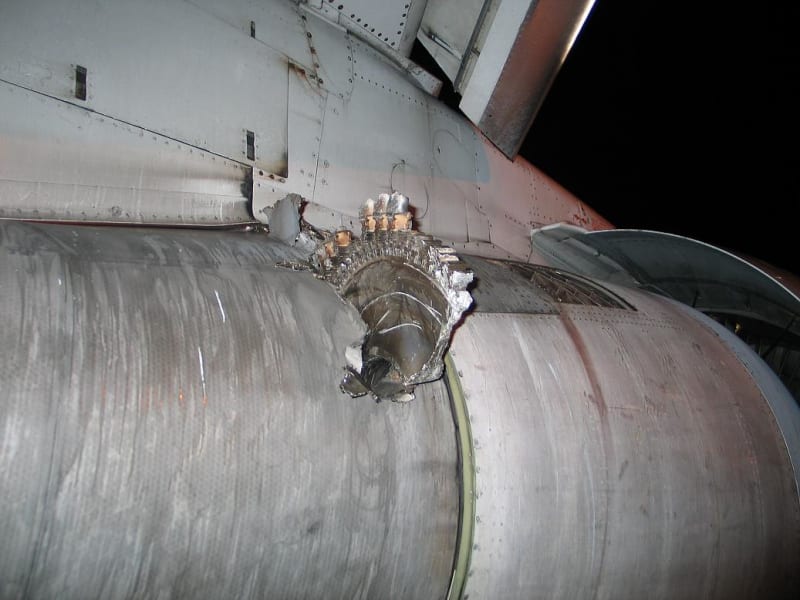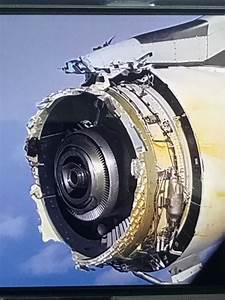Flight was able to land in Denver. No injuries reported. It was a Boeing 777.
Navigation
Install the app
How to install the app on iOS
Follow along with the video below to see how to install our site as a web app on your home screen.
Note: This feature may not be available in some browsers.
More options
Style variation
-
Congratulations cowski on being selected by the Eng-Tips community for having the most helpful posts in the forums last week. Way to Go!
You are using an out of date browser. It may not display this or other websites correctly.
You should upgrade or use an alternative browser.
You should upgrade or use an alternative browser.
United Flight from Denver to Hawaii blows engine on takeoff 12
- Thread starter magoo2
- Start date
- Status
- Not open for further replies.
Alistair_Heaton
Mechanical
A bypass turbofan engine has several section.
If we look at the picture above the fan is the big bit on the front. with the orange next to it. Most of the air goes past the core and down the sides of the engine. There are vanes and stuff to keep its flow laminar.
The certification is if a fan blade comes off it stay's inside the engine body.
Behind that you can see a route that starts blue and then heads towards the back turning red. That's what we call the core there are usually 4-5 compressor "disks" and then it goes into the combustion area and then into the turbine at the back 5-6 of them rotational speeds go up to 13000 rpm. The disk just in front of the combustion chamber is the fastest spinning. And that's where you may have a blanked off window if the wing doesn't shield the cabin from that area.
People think its normal to do this, but actually its a fudge when they stretch an old model and re-engine it with larger bypass engines that won't fit under the wings. If you look at modern fresh sheet designs they all have the engines placed so the wing acts as a shield.
Put it this way the 737-100 doesn't have it and the MAX does
If we look at the picture above the fan is the big bit on the front. with the orange next to it. Most of the air goes past the core and down the sides of the engine. There are vanes and stuff to keep its flow laminar.
The certification is if a fan blade comes off it stay's inside the engine body.
Behind that you can see a route that starts blue and then heads towards the back turning red. That's what we call the core there are usually 4-5 compressor "disks" and then it goes into the combustion area and then into the turbine at the back 5-6 of them rotational speeds go up to 13000 rpm. The disk just in front of the combustion chamber is the fastest spinning. And that's where you may have a blanked off window if the wing doesn't shield the cabin from that area.
People think its normal to do this, but actually its a fudge when they stretch an old model and re-engine it with larger bypass engines that won't fit under the wings. If you look at modern fresh sheet designs they all have the engines placed so the wing acts as a shield.
Put it this way the 737-100 doesn't have it and the MAX does
Alistair_Heaton
Mechanical
This is a disk failure. I can only presume they were at a low power setting when it went and no where near max N1.

Like it or not that cutting loose at 13000 rpm is not going to get stopped by 8 layers of Kevlar weave mat. Or if it is then it will cave in all the structure around the mat and you would have less damage if you just let it puncture its way through.
And here is another disk failure where the whole of the fan came off. That's the A380 over Greenland.


Like it or not that cutting loose at 13000 rpm is not going to get stopped by 8 layers of Kevlar weave mat. Or if it is then it will cave in all the structure around the mat and you would have less damage if you just let it puncture its way through.
And here is another disk failure where the whole of the fan came off. That's the A380 over Greenland.

"Success", as in "Any one you can walk away from ...".
And earlier in the day in Holland ...
And earlier in the day in Holland ...
Alistair_Heaton
Mechanical
I suspect it may come down to corrosion issues after them not flying much. Although the freighter's should have been flying.
-
1
- #25
SWComposites
Aerospace
Sigh. There is no kevlar wrap on fuselages. There is a fan case around the low speed fan, which is the brown component in the pictures of the failed engine. Fan cases often contain kevlar fibers. Normally the fan cowl covers that area, but it came off, even though it is not supposed to.
-
1
- #26
SWComposites
Aerospace
And the missing window area on fuselages is where the fuselage barrel sections are joined. Nothing to do with engine location. The exception is some turboprops that have a reinforced fuselage area in line with the propellers, since there is no fan case.
News...
"The Federal Aviation Administration (FAA) has issued an emergency order calling for inspections of Boeing 777s fitted with Pratt and Whitney engines just 24 hours after a mid-flight incident in Denver. In a statement released Sunday evening, FAA Administrator Steve Dickson said: 'After consulting with my team of aviation safety experts about yesterday's engine failure aboard a Boeing 777 airplane in Denver, I have directed them to issue an Emergency Airworthiness Directive that would require immediate or stepped-up inspections of Boeing 777 airplanes equipped with certain Pratt & Whitney PW4000 engines. This will likely mean that some airplanes will be removed from service.' Meanwhile, Japan announced on Sunday that 32 passenger jets that use the same family of engine as the Boeing 777 that caught fire during the United Airlines flight from Denver to Honolulu on Saturday, have been grounded. The planes affected by the order from the Ministry of Land, Infrastructure, Transport and Tourism, are 13 aircraft operated by Japan Airlines. The other 19 planes are operated by All Nippon Airways. None of the planes are scheduled to fly on Monday. Both announcements occurred a day after the United Airlines plane suffered catastrophic engine failure shortly after take-off. The Boeing 777-200 aircraft, carrying 231 passengers and 10 crew on board, was heading to Honolulu on Saturday from Denver International Airport when debris struck the plane’s right engine, causing it to erupt into flames. The incident forced the pilot to make an emergency landing back in Denver just 20 minutes after take-off, at around 1.30pm local time. Remarkably, there were no injuries reported either on board the flight or on the ground. "
Rather than think climate change and the corona virus as science, think of it as the wrath of God. Feel any better?
-Dik
"The Federal Aviation Administration (FAA) has issued an emergency order calling for inspections of Boeing 777s fitted with Pratt and Whitney engines just 24 hours after a mid-flight incident in Denver. In a statement released Sunday evening, FAA Administrator Steve Dickson said: 'After consulting with my team of aviation safety experts about yesterday's engine failure aboard a Boeing 777 airplane in Denver, I have directed them to issue an Emergency Airworthiness Directive that would require immediate or stepped-up inspections of Boeing 777 airplanes equipped with certain Pratt & Whitney PW4000 engines. This will likely mean that some airplanes will be removed from service.' Meanwhile, Japan announced on Sunday that 32 passenger jets that use the same family of engine as the Boeing 777 that caught fire during the United Airlines flight from Denver to Honolulu on Saturday, have been grounded. The planes affected by the order from the Ministry of Land, Infrastructure, Transport and Tourism, are 13 aircraft operated by Japan Airlines. The other 19 planes are operated by All Nippon Airways. None of the planes are scheduled to fly on Monday. Both announcements occurred a day after the United Airlines plane suffered catastrophic engine failure shortly after take-off. The Boeing 777-200 aircraft, carrying 231 passengers and 10 crew on board, was heading to Honolulu on Saturday from Denver International Airport when debris struck the plane’s right engine, causing it to erupt into flames. The incident forced the pilot to make an emergency landing back in Denver just 20 minutes after take-off, at around 1.30pm local time. Remarkably, there were no injuries reported either on board the flight or on the ground. "
Rather than think climate change and the corona virus as science, think of it as the wrath of God. Feel any better?
-Dik
More news... "Based on the initial information, we concluded that the inspection interval should be stepped up for the hollow fan blades that are unique to this model of engine, used solely on Boeing 777 airplanes."
maybe some sort of fatigue failure?
Rather than think climate change and the corona virus as science, think of it as the wrath of God. Feel any better?
-Dik
maybe some sort of fatigue failure?
Rather than think climate change and the corona virus as science, think of it as the wrath of God. Feel any better?
-Dik
Hollow fan blades? Is there a good reason for that?
JohnRBaker
Mechanical
Weight...
It's basically covered in this Wiki item:
John R. Baker, P.E. (ret)
EX-Product 'Evangelist'
Irvine, CA
Siemens PLM:
UG/NX Museum:
The secret of life is not finding someone to live with
It's finding someone you can't live without
It's basically covered in this Wiki item:
John R. Baker, P.E. (ret)
EX-Product 'Evangelist'
Irvine, CA
Siemens PLM:
UG/NX Museum:
The secret of life is not finding someone to live with
It's finding someone you can't live without
Alistair_Heaton
Mechanical
Swcomposites I was pretty sure jets didn't have it and went looking at pictures.
A220 doesn't have it.
Although there is some newish rule about control run protection near the engine line.
The turbo props is for ice shedding not for in the event the prop blade come off. I have seen a lump of ice get through it as well to make a hole in the hull. So I suspect it wouldn't have a chance against bits of metal coming out the casing that recently were doing 13000 rpm.
Nice to see the FAA actually did something quickly though...
Those engines are now banned from Japanese airspace.
A220 doesn't have it.
Although there is some newish rule about control run protection near the engine line.
The turbo props is for ice shedding not for in the event the prop blade come off. I have seen a lump of ice get through it as well to make a hole in the hull. So I suspect it wouldn't have a chance against bits of metal coming out the casing that recently were doing 13000 rpm.
Nice to see the FAA actually did something quickly though...
Those engines are now banned from Japanese airspace.
Alistair_Heaton
Mechanical
On a historical note my Grandad at RR Barnsalwick worked on first acid etched turbine bladeds with cooling holes through the middle of them as a technician doing the grunt work. .
Alistair_Heaton
Mechanical
This is the humour that's going round the spanner gods. That fix what I break.


and more news...
"The crack that led the fan blade to break on the United flight on Saturday was similar to one that occurred on a 2018 United flight, a person familiar with the preliminary investigation results who was not authorised to discuss them told the Bloomberg news agency.
In the latest failure, one fan blade cracked and broke off near where it attached to a rotating hub, according to the person. A second blade was also broken, apparently after it was struck by the first blade.
The fan blades on this specific type of PW4000 are hollow and made of titanium. The cracks appear to start from within the surface, making them impossible to detect on the surface. Airlines can use technologies such as ultrasound to find cracks beneath the surface.
Japan’s transport ministry ordered Japan Airlines Co Ltd (JAL) and ANA Holdings Inc to suspend the use of 777s with PW4000 engines while it considered whether to take additional measures."
Rather than think climate change and the corona virus as science, think of it as the wrath of God. Feel any better?
-Dik
"The crack that led the fan blade to break on the United flight on Saturday was similar to one that occurred on a 2018 United flight, a person familiar with the preliminary investigation results who was not authorised to discuss them told the Bloomberg news agency.
In the latest failure, one fan blade cracked and broke off near where it attached to a rotating hub, according to the person. A second blade was also broken, apparently after it was struck by the first blade.
The fan blades on this specific type of PW4000 are hollow and made of titanium. The cracks appear to start from within the surface, making them impossible to detect on the surface. Airlines can use technologies such as ultrasound to find cracks beneath the surface.
Japan’s transport ministry ordered Japan Airlines Co Ltd (JAL) and ANA Holdings Inc to suspend the use of 777s with PW4000 engines while it considered whether to take additional measures."
Rather than think climate change and the corona virus as science, think of it as the wrath of God. Feel any better?
-Dik
LittleInch
Petroleum
Suspended worldwide by Boeing.
Hollow fan blades eh?
Remember - More details = better answers
Also: If you get a response it's polite to respond to it.
Hollow fan blades eh?
Remember - More details = better answers
Also: If you get a response it's polite to respond to it.
Alistair_Heaton
Mechanical
That's not duct tape wash your mouth out. 
Its called speed tape and is metal and costs about 50$ a roll. The technicians even have to go on special courses to be able to use it. It will stay stuck on even at 400 knts. They have a variety of tools to apply it.
There are even limits to the amount of it that can be used in certain areas. Some airlines survive on the stuff. Its one of the things I look for when I board a plane as a pax. The amount of it they have used and where it is. The more of it you see the more dodgy the maint level is. My current company the boss has banned it apart from get home outstation fixes.
Its called speed tape and is metal and costs about 50$ a roll. The technicians even have to go on special courses to be able to use it. It will stay stuck on even at 400 knts. They have a variety of tools to apply it.
There are even limits to the amount of it that can be used in certain areas. Some airlines survive on the stuff. Its one of the things I look for when I board a plane as a pax. The amount of it they have used and where it is. The more of it you see the more dodgy the maint level is. My current company the boss has banned it apart from get home outstation fixes.
-
1
- #38
LittleInch
Petroleum
Very interesting article on a previous blade failure and also how the inspections were a bit dubious
Remember - More details = better answers
Also: If you get a response it's polite to respond to it.
Remember - More details = better answers
Also: If you get a response it's polite to respond to it.
Lou Scannon
Automotive
There has been reference to rpm in this thread, but a more relevant parameter with regard to kinetic energy is blade tip speed. Naturally, the larger the blade diameter, the heavier the blade (generally), hence the greater the kinetic energy on the loose if it happens to shed.
"Schiefgehen wird, was schiefgehen kann" - das Murphygesetz
"Schiefgehen wird, was schiefgehen kann" - das Murphygesetz
LittleInch
Petroleum
Hence the need to have hollow blades.
I think they are fairly unique to that engine, or at least I hope so.
Remember - More details = better answers
Also: If you get a response it's polite to respond to it.
I think they are fairly unique to that engine, or at least I hope so.
Remember - More details = better answers
Also: If you get a response it's polite to respond to it.
- Status
- Not open for further replies.
Similar threads
- Replies
- 24
- Views
- 6K
- Locked
- Question
- Replies
- 65
- Views
- 20K
- Question
- Replies
- 8
- Views
- 12K
- Locked
- Question
- Replies
- 19
- Views
- 957
- Replies
- 12
- Views
- 7K
